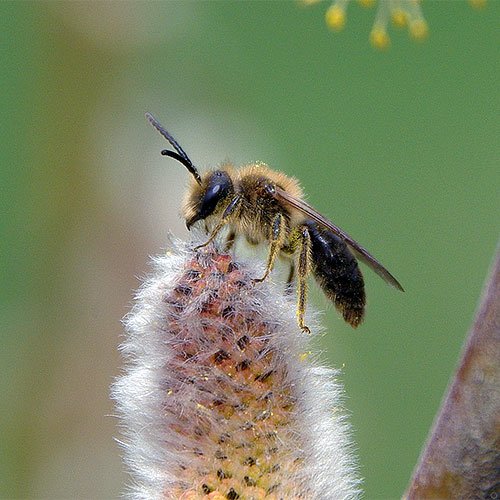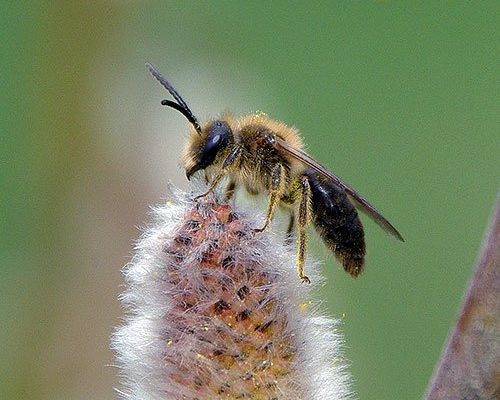
Mining bees are often overlooked, but they are incredible pollinators and play an essential role in our ecosystems. Just imagine a world without these tireless workers—many of our favorite fruits and vegetables could be in serious trouble! While honeybees have been domesticated for thousands of years, mining bees present different challenges. Let’s dive deeper into what making these bees part of your gardening or farming routine might look like.
What Are Mining Bees?
Mining bees, belonging to the family Andrenidae, are solitary bees that create nests underground. They’re small, generally about the size of a finger nail, and come in various species, each with its unique features. These bees usually emerge in early spring when flowers begin to bloom.
Imagine the excitement of watching a tiny engineer at work! Mining bees dig individual tunnels in loose soil, often in sunny areas. They collect pollen and nectar to feed their young, making them crucial to pollination. Unlike honeybees, which live in colonies, mining bees are solitary, which means each female raises her brood independently.
You might be wondering how their nesting habits affect their role in the garden. Since they prefer sandy or loose soils, you’ll often see them in flower beds or meadows. This makes them the perfect candidates for keeping if you want to boost your garden’s health without the complexity of traditional beekeeping.
Can Mining Bees Be Domesticated?
The short answer? Not really, at least not in the same way as honeybees. Honeybees have been bred over generations for traits like honey production and docility. Mining bees, on the other hand, don’t form colonies or have the same social structures. They are wild creatures that thrive in their natural environments.
Here’s the thing: while you can’t domesticate mining bees in the traditional sense, you can absolutely create a welcoming habitat for them. This means planting the right flowers, ensuring a sunny area for nesting, and avoiding pesticides. By doing this, you can encourage mining bees to visit your garden and, in effect, “keep” them in a way that benefits both you and the bees.
Think of your role as a habitat creator rather than a beekeeper. Your garden will flourish with these pollinators, especially since they’re known for their efficiency in transferring pollen from flower to flower.
How To Attract Mining Bees to Your Garden
If you’re feeling inspired to encourage mining bees in your yard, here are some helpful tips to get started:
- Choose Native Flowers: Opt for a variety of native wildflowers that bloom in spring and early summer.
- Provide Nesting Sites: Leave patches of bare soil for mining bees to burrow. They prefer sandy or loamy soil.
- Avoid Pesticides: Chemicals can be harmful to bees. Stick to organic gardening practices.
- Water Source: Create a small water feature or leave a shallow dish of water out for them to hydrate.
Creating a bee-friendly garden means thinking about what they need to thrive. Even small changes can make a big difference. For example, maybe you’ve noticed some of your neighbors have beautiful flower gardens—consider asking them about their methods. Often, simplicity is key!
Common Challenges of Keeping Mining Bees
While motivating mining bees to visit your garden sounds simple, there are challenges to consider. Here are a few potential hiccups you might encounter:
- Soil Conditions: Not all gardens have suitable soil for mining bees. Heavy clay or compacted soil will make it tough for these bees to burrow.
- Predators: Unfortunately, mining bees have their enemies—birds and other insects can pose a threat to their nests.
- Seasonal Changes: Because mining bees emerge in spring, their activity depends on weather patterns. Unpredictable weather can affect their life cycles.
Navigating these challenges takes some patience, but the rewards are worth it. The vibrant life they bring to your garden can be visually stunning, and you’ll be contributing positively to your local ecosystem.
The Benefits of Having Mining Bees
Having mining bees around your garden provides numerous benefits. Here’s why you might consider attracting them:
- Pollination: Mining bees are fantastic pollinators! They can increase the yield of your fruits and vegetables by helping plants reproduce.
- Biodiversity: Encouraging these bees promotes a more diverse ecosystem. The presence of various species creates a balance that benefits all plants and animals.
- Low Maintenance: Once you’ve created a welcoming environment, mining bees do their thing with little intervention needed from you.
If you think about it, you’re not just gardening; you’re supporting an intricate web of life. You’ll find joy in watching these little guys go about their business, knowing you’re playing a part in something much larger.
Mining Bees vs. Honeybees: What’s the Difference?
While both mining bees and honeybees are vital to the environment, they have significant differences. Here’s a simple breakdown:
| Feature | Mining Bees | Honeybees |
|---|---|---|
| Social Structure | Solitary | Social |
| Nesting Habits | Underground tunnels | Hives |
| Honey Production | No | Yes |
| Pollination | Specializes in native plants | Pollinates a wide range of crops |
Both types of bees play integral and complementary roles in our environment. While honeybees may steal the spotlight with their sweet honey, mining bees quietly do a fantastic job of pollinating our native flora.
Final Thoughts on Keeping Mining Bees
So, the gist of the matter is this: you can’t keep mining bees in the traditional sense like you would with honeybees, but you can create an inviting space for them to thrive. The best part? You’ll be helping the environment while enjoying the beauty of your flourishing garden.
By choosing the right flowers, maintaining soil conditions, and letting nature take its course, you can appreciate these marvels of nature in your backyard. It’s all about partnership—with the bees playing their role and you creating an environment for them to thrive.
If you’re interested in pollinator-friendly gardening or just want to do your part for the environment, welcoming mining bees into your yard could be a rewarding endeavor.

